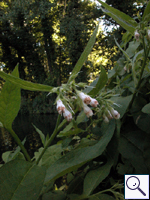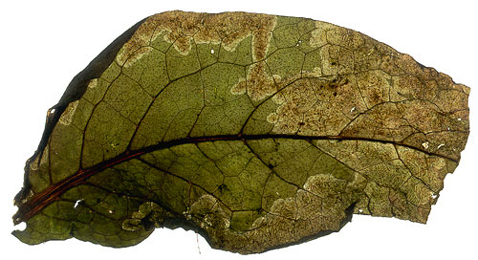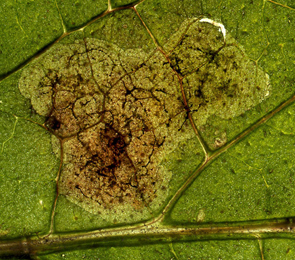|
||||||
|
SYMPHYTUM. Comfreys. [Boraginaceae] |
|
|
Nine species of Symphytum are recorded in Britain. These include the native Tuberous Comfrey (S. tuberosum) and Common Comfrey (S. officinale). The BSBI provide a downloadable plant crib for Symphytum. Eight British miners are recorded on Symphytum. The agromyzid Melanagromyza symphyti bores the stems or leaf stalks of Symphytum in Britain. A key to the European miners recorded on Symphytum is provided in Bladmineerders van Europa. |
 Common Comfrey Symphytum officinale |
Key for the identification of the known mines of British |
Note: Diptera larvae may live in a corridor mine, a corridor-blotch mine, or a blotch mine, but never in a case, a rolled or folded leaf, a tentiform mine or sandwiched between two more or less circular leaf sections in later instars. Pupation never in a cocoon. All mining Diptera larvae are leg-less maggots without a head capsule (see examples). They never have thoracic or abdominal legs. They do not have chewing mouthparts, although they do have a characteristic cephalo-pharyngeal skeleton (see examples), usually visible internally through the body wall. The larvae lie on their sides within the mine and use their pick-like mouthparts to feed on plant tissue. In some corridor miners frass may lie in two rows on alternate sides of the mine. In order to vacate the mine the fully grown larva cuts an exit slit, which is usually semi-circular (see Liriomyza huidobrensis video). The pupa is formed within the hardened last larval skin or puparium and as a result sheaths enclosing head appendages, wings and legs are not visible externally (see examples). See Key to non-Diptera. |
1a > Leaf-miner: A large blotch mine, several larvae feeding together (Spencer, 1972b: 31). A dozen eggs are deposited in a semicircle at the leaf underside. After hatching the larvae eat themselves a communual corridor. After the first moult they begin the making of a very large, dark brown communal blotch, with conspicuous secondary feeding lines. |
 Mine of Agromyza ferruginosa on Symphytum officinale Image: © Willem Ellis (Bladmineerders van Europa) |
|
Agromyza ferruginosa Wulp, 1871 [Diptera: Agromyzidae]. |
1b > Leaf-miner: A large, irregular blotch mine with a short linear section in the first instar which is frequently entirely enveloped in the fully developed mine and may then be no longer visible (Spencer, 1976: 124). Perhaps the only character differentiating it from abiens is the presence of several larvae in a fully developed mine of abiens and just one in myosotidis. Puparium reddish brown |
|
Agromyza myosotidis Kaltenbach, 1864 [Diptera: Agromyzidae]. |
1c > Leaf-miner: A narrow linear leaf-mine, which developes into a large blotch. Several larvae frequently feed together and the resulting mine can entirely fill the leaf (Spencer, 1976: 89). The mine begins with a narrow, parallel sided corridor af 1-8 cm in length, with a nice double frass line. After the first moult the corridor is succeeded, and mostly overrun, by a large, primary, brown blotch. Frass in the initial corridor in short thread fragments, in the blotch in angular granules and thread fragments that often are branching (the frass is unusally sticky). Primary and secondary feeding lines conspicuous. The final mine often is very large and generally contains several larvae, because normally several mines develop on a leaf, and coalesce into one big blotch. Before pupation the larvae leave the mine through a semicircular exit slit that mostly, but not invariably, is in the upper epidermis. The initial narrow gallery contains frass in a double line. It then expands to form a blotch mine. Several larvae may occupy a leaf to form a large blotch. |
|
Agromyza abiens Zetterstedt, 1848 [Diptera: Agromyzidae]. |
1d > Leaf-miner: Mine initially linear, later developing into a whitish blotch, becoming blackish. Pupation in mine on lower surface. The mine begins as an upper surface blotch in the centre of the leaf, from where corridors radiate, each with one larva. After a while these rays fuse, resulting in one large, brown, blotch. Frass in irregular strings. Pupation in principle outside the mine, exit slit in lower epidermis (always?). Often the puparium protrudes from the opening. Puparium normally dark reddish brown |
 Mine of Phytomyza medicaginis on Symphytum officinale Image: © Willem Ellis (Bladmineerders van Europa) |
|
Phytomyza medicaginis Hering, 1925 [Diptera: Agromyzidae]. |
Key for the identification of the known mines of British |
Note: The larvae of mining Coleoptera, Hymenoptera and Lepidoptera may live in a corridor mine, a corridor-blotch mine, a blotch mine, a case, a rolled or folded leaf, a tentiform mine or sandwiched between two more or less circular leaf sections in later instars. Larva may pupate in a silk cocoon. The larva may have six legs (although they may be reduced or absent), a head capsule and chewing mouthparts with opposable mandibles (see video of a gracillarid larva feeding). Larvae of Hymenoptera and Lepidoptera usually also have abdominal legs (see examples). Frass, if present, never in two rows. Unless feeding externally from within a case the larva usually vacates the mine by chewing an exit hole. Pupa with visible head appendages, wings and legs which lie in sheaths (see examples). |
| 1a > Leaf-miner and case-bearer: The larva lives outside the mine, protected by a case, and feeds on the underlying plant tissues via a hole cut in the epidermis. From that point it eats away as much leaf tissue as it can reach without fully entering the mine. Mine does not contain frass (Coleophora species) |
1b > Leaf-miner, but not a case-bearer: The larva lives mainly inside the mine. Mine usually contains frass. In later instars the larva may live sandwiched between two more or less circular sections cut from the leaf. |
2 > Leaf-miner and case-bearer: The larva feeds in a distinctive case made from hairy leaf fragments of the foodplant. The young larva feeds on the developing seeds and hibernates in its first case which is made of the tip of a petal. After hibernation it makes a hoary, laterally flattened composite leaf case (resembling a willow catkin). Full depth mines are made at the margin of the leaves, that thereby look peculiarly damaged. Mouth angle 70°. Initially forms a blotch mine, in the centre of a leaf, which it excises for its initial case. In the spring it repeatedly extends its case and it resembles a jagged catkin of willow. The larva may wander from its foodplant and attach to other plants or fences etc. |
|
| Coleophora pennella (Denis & Schiffermüller, 1775) [Lepidoptera: Coleophoridae]. |
3a > Leaf-miner: Mine upper-surface or, more often, lower-surface. At first a long, narrow, winding epidermal gallery with central, more or less deliquescent, reddish brown frass. The gallery abruptly widens into an elongate blotch that is epidermal at first but soon deeper; the blotch is brown with strikingly white margins. Epidermis finely wrinkled. Lower surface mines strongly contract the leaf (and often there is a mine at either side of the midrib). 2-3 Larvae in a blotch, each with its own initial corridor. Frass in large black grains in a central depot; moreover in the form of very thin threads stuck in a reticulate pattern in the epidermis. |
|
Dialectica scalariella (Zeller, 1850) [Lepidoptera: Gracillariidae]. |
3b > Leaf-miner: In the first instar the larva mines the leaves, forming short, irregular, blotch-like mines, but in later instars it lives externally, feeding in spun leaves and often twisting those of tender shoots. Larval head light-brown or yellowish brown, edged with black postero-laterally, ocellar area blackish; prothoracic plate black edged with whitish anteriorly; abdomen dull dark green; pinacula distinct, black, sometimes brownish but with black bases to setae; anal plate large, black (Bradley et al., 1973). Small, full depth mine without a definite shape; little frass. Some silk is deposited in the mine. The larva soon leaves the mine and continues feeding among spun leaves. |
|
Cnephasia incertana (Treitschke, 1835) [Lepidoptera: Tortricidae]. |
3c > Leaf-miner: The initial gallery is soon absorbed into a blotch. The blotch is squarish as the larva eats through the leaf parenchyma to the upper epidermis. the blotch turns brown and care must be taken to distinguish these mines from diptera - which can form blackish blotches. The larva makes a small, lower-surface spiralling corridor that soon gives way to a blotch that overuns the previous work. Gradually the mine becomes deeper, and finally is locally full depth. Only then the mine is apparent from above as some disconnected brownish spots. On the underside the mine is larger, membranous. The frass initially is in strings, but later it becomes a network of thin threads. Pupation usually is outside the mine. |
|
| Dialectica imperialella (Zeller, 1847) [Lepidoptera: Gracillariidae]. |
| Last updated 30-Jan-2018 Brian Pitkin | ||
